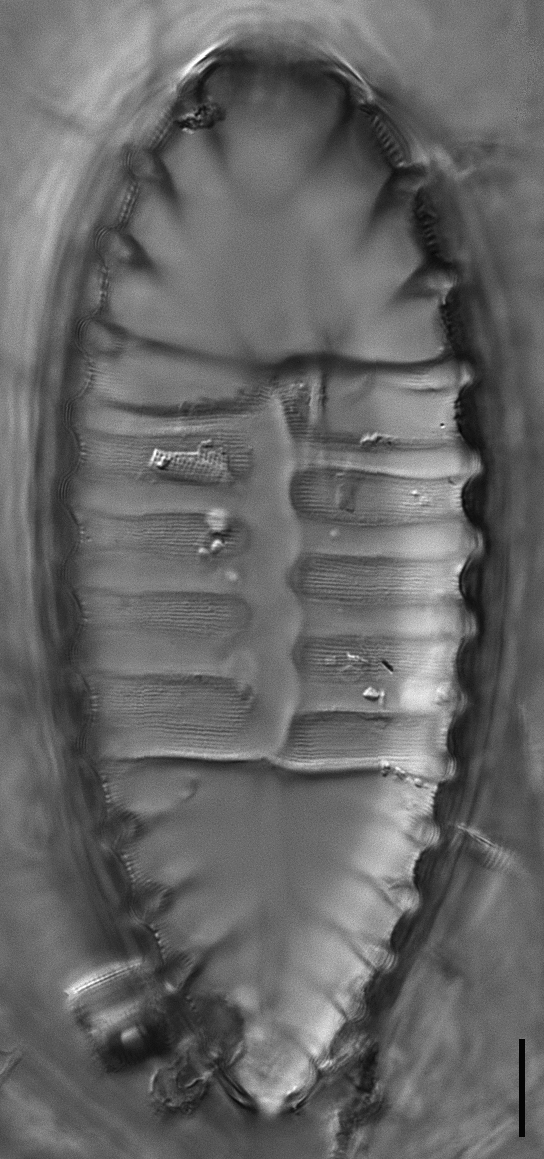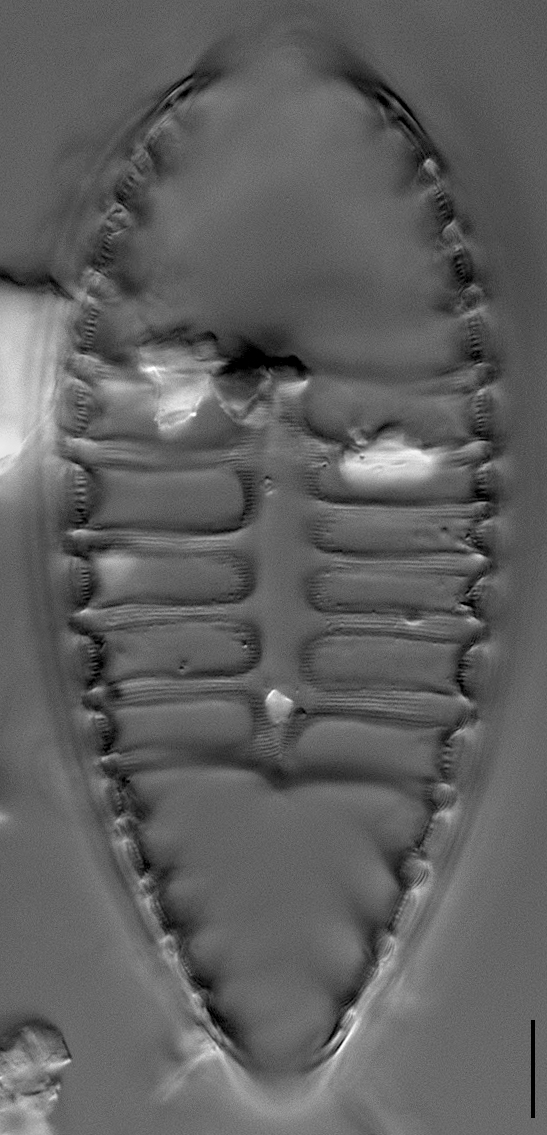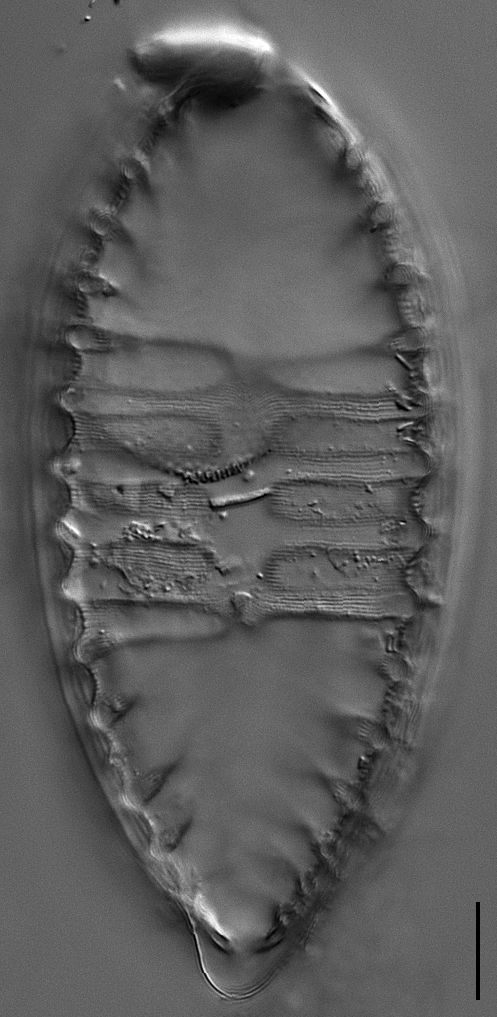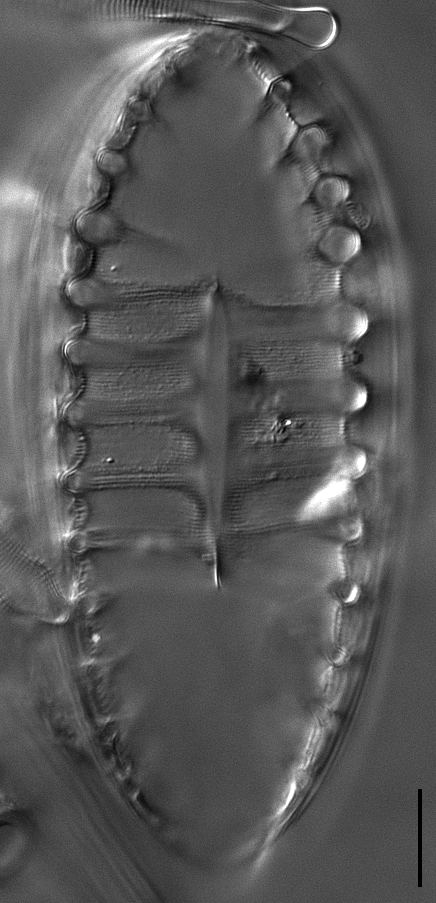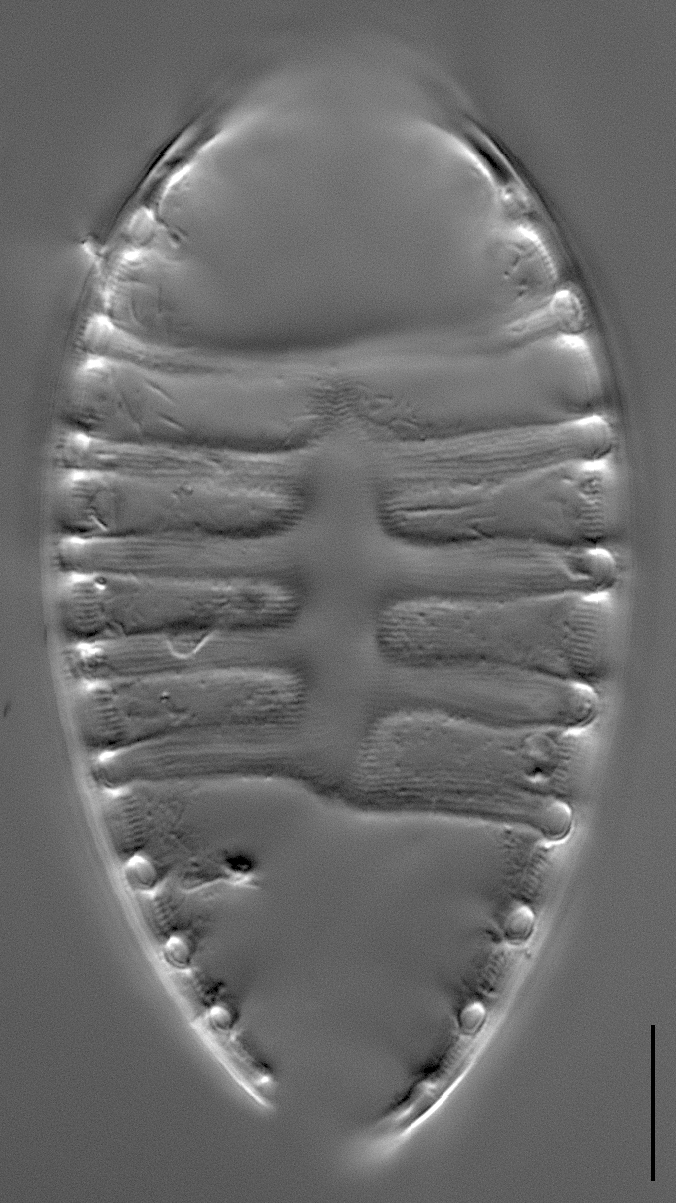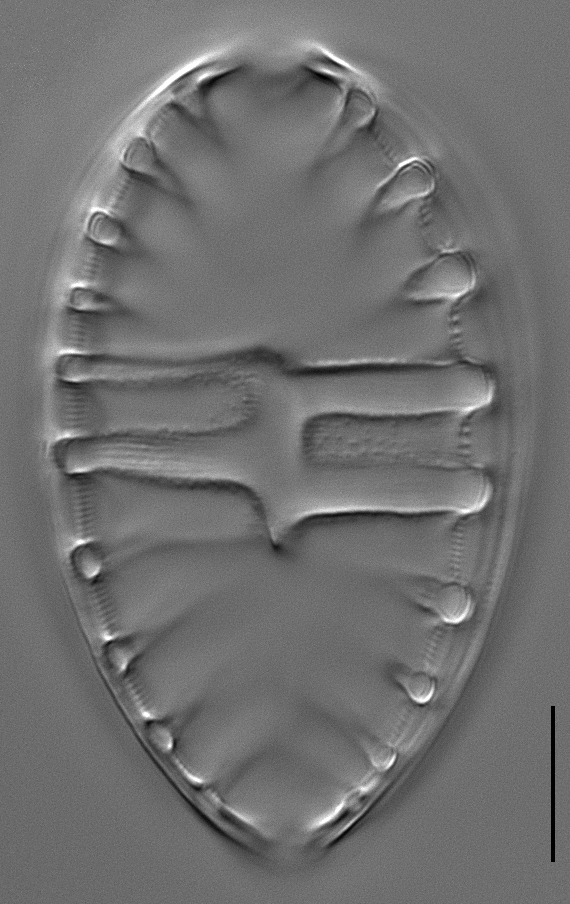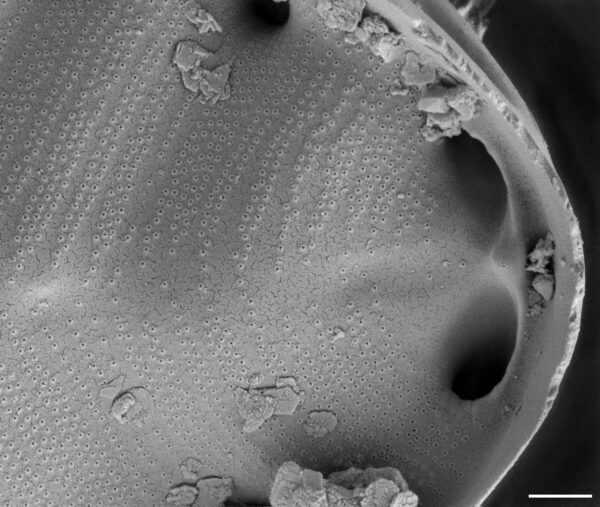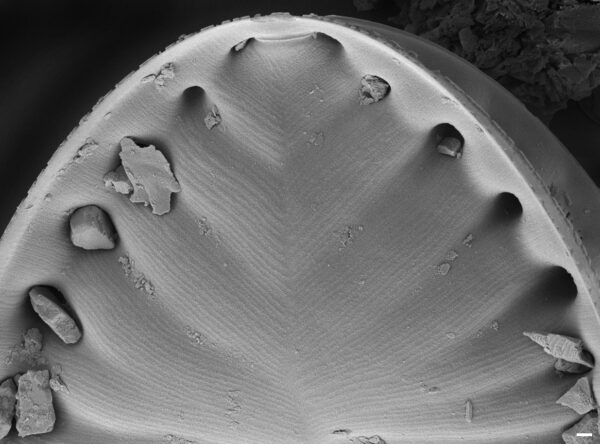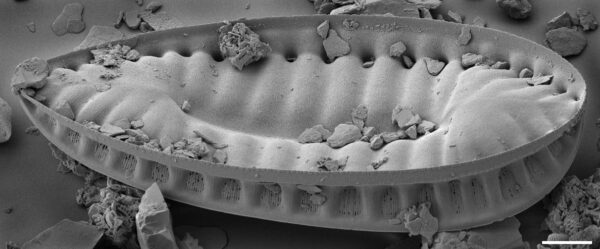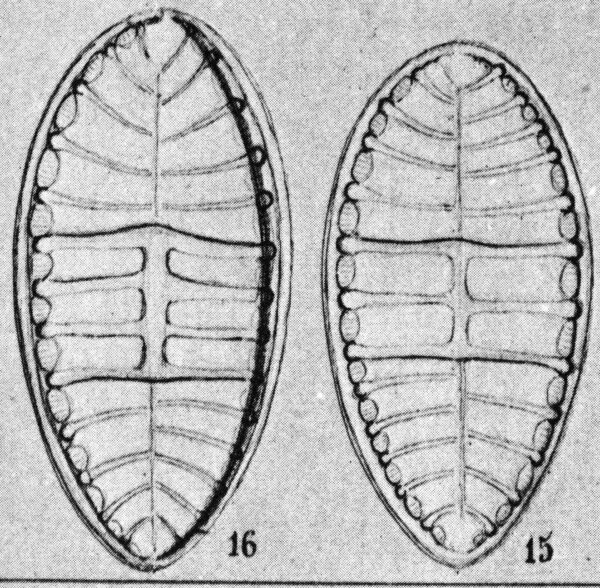Surirella cruciata
-
Category
-
Length Range48–160 µm
-
Width Range24–61 µm
-
Striae in 10 µm19–29 in the center valve, 22–30 at the ends
-
ContributorJana Veselá - Nov 2012
-
ReviewerMarina Potapova - Nov 2013
Identification
Description
Valves are obovoid with cuneate footpoles and broadly rounded headpoles. Valves are distinctly heteropolar in larger specimens, becoming less heteropolar in smaller specimens, with the valve length to width ratio ranging from 1.6 to 3.2. The valve face is distinctly and abruptly raised in the central third of the valve, depressed and shallowly concave in the apical thirds of the valve. The wings are well developed and raised prominently from the valve face. Raphe is situated in a raised raphe canal. The alar canals are narrower than the fenestrae, usually even in density throughout, but becoming occasionally variable in density in a single valve, 11–26 in 100 μm. The fenestrae are greater in hight than width in the central part of the wing, having 5–9 fenestral bars (8-9 in the middle part, 5 near apices), occluded or partially open between bars. The axial area is narrow, elevated in a shallow keel that is raised above the level of the porcae, without ornamentation or pores. The porcae are pronounced in the central part of valve, shallow and shortened in the outer thirds of the valve. The arrangement of porcae is opposite to alternate in the same valve. The porcae are unornamented, with a depression between porcae bearing minute granules, which are more or less visible in LM. The striae are bi- to triseriate, often becoming uniseriate towards the axial area and radiate at the apices. The areolae, 53–64 in 10 μm, are occluded externally, circular and opened with a small rim internally. Numerous silica plaques are present on the valve mantle near the edge with the valvocopula. The girdle bands are unornamented, thin and open. Chloroplasts were not observed.
Autecology
S. cruciata was observed in 11 freshwater localities in northeastern North America (including 6 sites in Maine; Sycamore Lake, NJ; Hamlin’s Pond, CT; Grays Ferry, PA; Little Simon Pond, NY; and a pond in Nova Scotia, Canada), and in Lake Ozette in Washington State on the west coast of the USA. In addition to the clearly freshwater habitats, S. cruciata was also found in 3 freshwater habitats with clear marine intrusions, as evidenced by the presence of both strictly freshwater and strictly marine taxa. These sites of unclear or variable salinity included Pensacola in Florida, Delaware River in New Jersey and Nanticoke River in Delaware. The specimens from the localities with marine–brackish influence tended to be smaller [48–82(92) μm long, 24–42 μm wide] and had slightly finer striation (26–29 in 10 μm) compared with the populations from strictly freshwater habitats (62–160 μm long, 27–61 μm wide, 19–29 striae in 10 μm). The populations from Nova Scotia, Canada, and New York State, USA, also appeared distinctive, having a larger length to breadth ratio than the other freshwater populations. The New York populations were also evidently more granular on their valve surfaces.
-
Size Range, µm3
-
Motility
-
Attachment
-
Habitat
-
Colony
-
Waterbody
-
Distribution
- Learn more about this
Citations & Links
Citations
-
Publication Link: 10.1080/0269249X.2013.853697
Links
-
Index Nominum Algarum
Cite This Page
Veselá, J. (2012). Surirella cruciata. In Diatoms of North America. Retrieved November 21, 2024, from https://diatoms.org/species/surirella_cruciata
Responses
The 15 response plots show an environmental variable (x axis) against the relative abundance (y axis) of Surirella cruciata from all the stream reaches where it was present. Note that the relative abundance scale is the same on each plot. Explanation of each environmental variable and units are as follows:
ELEVATION = stream reach elevation (meters)
STRAHLER = distribution plot of the Strahler Stream Order
SLOPE = stream reach gradient (degrees)
W1_HALL = an index that is a measure of streamside (riparian) human activity that ranges from 0 - 10, with a value of 0 indicating of minimal disturbance to a value of 10 indicating severe disturbance.
PHSTVL = pH measured in a sealed syringe sample (pH units)
log_COND = log concentration of specific conductivity (µS/cm)
log_PTL = log concentration of total phosphorus (µg/L)
log_NO3 = log concentration of nitrate (µeq/L)
log_DOC = log concentration of dissolved organic carbon (mg/L)
log_SIO2 = log concentration of silicon (mg/L)
log_NA = log concentration of sodium (µeq/L)
log_HCO3 = log concentration of the bicarbonate ion (µeq/L)
EMBED = percent of the stream substrate that is embedded by sand and fine sediment
log_TURBIDITY = log of turbidity, a measure of cloudiness of water, in nephelometric turbidity units (NTU).
DISTOT = an index of total human disturbance in the watershed that ranges from 1 - 100, with a value of 0 indicating of minimal disturbance to a value of 100 indicating severe disturbance.
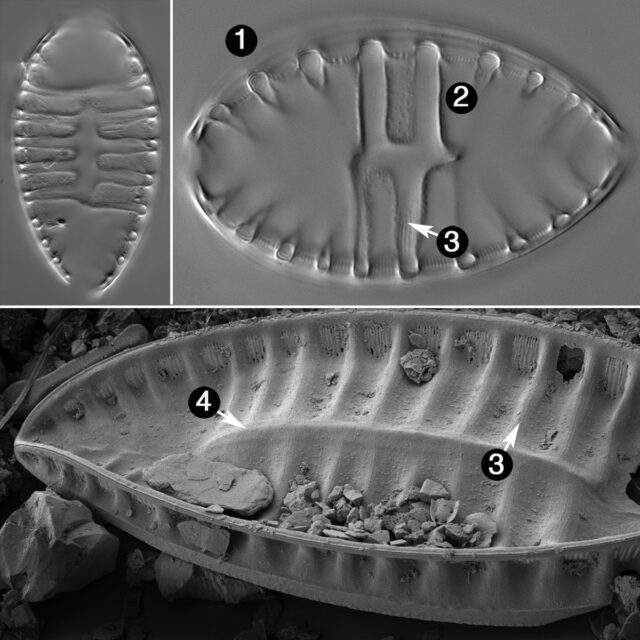
Surirella cruciata
- Valve with cuneate footpole and broadly rounded headpole
- Central part of valve distinctly raised
- Central porcae distinct
- Axial area narrow, elevated in a keel
Valves are obovoid with cuneate footpole and broadly rounded headpole. Larger specimens are distinctly heteropolar. The valve face is distinctly and abruptly raised in the central third of the valve. Porcae are pronounced in the central part of valve, arranged in an opposite to alternate pattern. The axial area is narrow, lacks...
 Diatoms of North America
Diatoms of North America